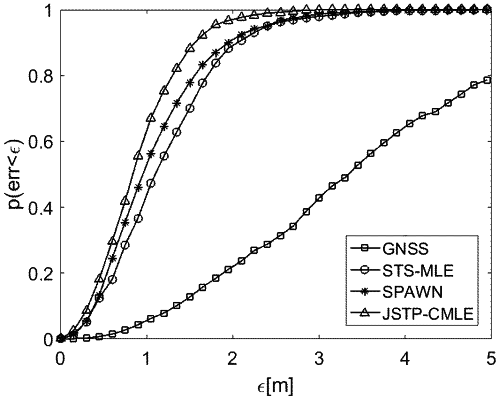| CPC G01S 5/0294 (2013.01) [G01S 5/0289 (2013.01); G01S 2205/03 (2020.05)] | 2 Claims |

|
1. A centralized cooperative positioning method of a centralized cooperative positioning system based on joint time-space processing, wherein there are nodes and a central processing node in the system and the central processing node is responsible for positioning all nodes; the central processing node comprises a multi-slice measurement cache module (101), a trajectory calculation module (102), an initial state estimation module (103) and a joint time-space processing module (104); measurements are used as input of the multi-slice measurement cache module (101) and the initial state estimation module (103), a state variable of each node in a current time slice is used as input of the trajectory calculation module (102), and output of the multi-slice measurement cache module (101), the trajectory calculation module (102) and the initial state estimation module (103) is used as input of the joint time-space processing module (104), and output of the joint time-space processing module (104) is used as result;
wherein the centralized cooperative positioning method comprises:
(1) during each time slice, caching, by the multi-slice measurement cache module which is used as a data cache module, all measurements of all nodes in the system in multiple time slices up to the current time slice, and sending the measurements into the joint time-space processing module;
(2) calculating, by the trajectory calculation module, location information of all the nodes in the system in the multiple time slices based on state variables of all the nodes in the system in the current time slice to obtain trajectory information of all the nodes in the multiple time slices, and sending the trajectory information of all the nodes into the joint time-space processing module;
in which (2) comprises:
calculating location information of each node in previous K−1 time slices based on a location variable xmk of the node in the current time slice and a mobility state variable of the node, in a case that a number of the considered multiple consecutive time slices is small, it is reasonable to assume that each node moves along a straight line with a constant acceleration in K time slices, location information of node m at time slice t∈
 , is defined, based on a mobility state of node m at time slice k, as: , is defined, based on a mobility state of node m at time slice k, as: where, vmk represents a velocity of node m at time slice k, αmk represents an acceleration, ΔTt=(t−k)ΔT, ΔT represents a length of the time slice, and the above formula represents trajectory of node m from time slice τ to the current time slice k during the K time slices ; the state variable of the node is defined as:
 the trajectory of node m is expressed as:
 where I2 represents a 2×2 unit matrix and trajectories of all the nodes are sent to the joint time-space processing module;
(3) performing, by the initial state estimation module, initial state estimations of all the nodes in the system based on the measurements of a single time slice; sending the initial state estimations to the joint time-space processing module;
in which a to-be-estimated variable at the current time slice is defined as Xmk=[(xmk)T,(vmk)T]T, where xmk=[xmk, ymk]T, vmk=[xmk, ymk]T; Xmk at the current time slice is predicted based on a posterior estimator Xmk−1 at time slice k−1 as:
 where matrix F is denoted as:
 02 represents a 2×2 all-zero matrix, Pmk−1 represents a covariance matrix of estimator Xmk−1, Qmk represents a covariance matrix of system modeling noise, a Jacobian matrix of the measurements rmk about Xmk as:
 a measurement residual and a covariance matrix of the measurement residual are calculated as:
 where
 n1, n2, . . . , nNm represents all neighboring nodes of node m and matrix Rmk is a diagonal matrix as:
Rmk=diag{(σmn1k)2,(σmn2k)2, . . . ,(σmnNmk)2};
a Kalman gain is calculated as:
 a posterior estimation and a covariance matrix of Xmk is calculated as:
 the estimations are used as the initial state estimations of the nodes and sent to the joint time-space processing module;
(4) using, by the joint time-space processing module, the initial state estimations provided by the initial state estimation module, as initial solution values, performing the joint time-space processing on the measurements of all the nodes in the system in the multiple time slices based on trajectory constraints, to obtain a state estimation of each node at the current time slice, in which the state estimation includes an estimated value of a location of each node;
in which (4) comprises:
fusing, by the joint time-space processing module, the measurements in the multiple time slices using the trajectory constraints of all the nodes, based on the initial state estimations provided by the initial state estimation module, to obtain the state estimation of each node at the current time slice, in which the state estimation includes the estimated value of the location of the node, zk=[z1k, z2k, . . . , zMk] is defined, M represents a number of all the nodes in the system, and a maximum likelihood estimation of zk is obtained based the measurements xT and rT in the multiple time slices as:
 |